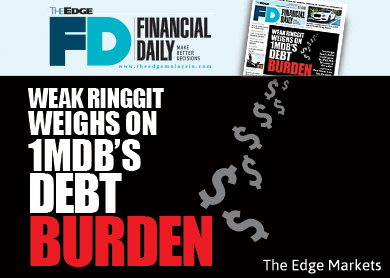
KUALA LUMPUR: The recent sharp depreciationof the ringgit will not augur well for 1Malaysia Development Bhd (1MDB), which has US dollar-denominated debt of US$7.4 billion (RM25.7 billion).
1MDB had US-dollar loans of about RM22.25 billion according to the sovereign fund’s financial statements for the financial year ended March 31, 2014 (FY14), more than half of its RM42 billion in debts. However, as the ringgit has declined by 6.5% in the past nine months to 3.48 against the greenback, the same US$7.4 billion in debts have ballooned to about RM25.7 billion — an increase of about RM3.96 billion.
This means that 1MDB would incur an unrealised foreign exchange loss of RM3.96 billion, exerting more pressure on the fund to meet its debt obligations if the ringgit stays depressed.
Even when the ringgit was averaging at between 3.00 and 3.20 against the US dollar in FY14, 1MDB’s finance costs were already a whopping RM2.4 billion, resulting in a cash flow deficit of RM2.25 billion.
Nonetheless, 1MDB had a substantial amount of US-dollar denominated assets of RM21.41 billion on the other side of its balance sheet as at March 31.
With that one may say that the sovereign fund’s net exposure is barely RM837 million. Therefore, the sensitivity analysis in the financial statements shows that a 10% swing in the ringgit exchange rate against the greenback would amount to only an extra of RM83.7 million in 1MDB’s net liabilities.
But that may not show the full picture because 1MDB’s assets are not generating enough cash flow to service its debts. Because of that, the sovereign fund, which posted a net loss of RM665.3 million for FY14, has kept issuing debt papers to raise fresh capital to meet its debt obligations and fund asset acquisitions.
A large bulk of IMDB’s US-dollar denominated assets is in the form of assets available for sale worth about RM12.88 billion, according to its FY14 accounts, and receivables account for RM4.7 billion.
At best, 1MDB can sell some of its US-dollar assets to meet its foreign debt obligations — which it had done before.
Notes attached to 1MDB’s latest financial accounts reveal that the fund sold almost half of its US$5.33 billion assets available for sale to meet debt obligations and fund working capital.
These assets available for sale are the money sent to the Cayman Islands and it is being managed by Hong Kong-based Bridge partners. According to 1MDB’s statements, approximately US$2.67 billion of the funds remain invested while the rest has been utilised for debt repayments and working capital.
It doesn’t help that 1MDB is paying a relatively high coupon rate for its US dollar bonds as lenders priced in the foreign exchange risk, exacerbating even more pressure on the sovereign fund. In a nutshell, 1MDB seems to have a mismatch between its earnings/cash flow and debt obligations.
But some quarters may argue that most of 1MDB’s debts are long-term 10-year notes. If the ringgit recovers, the debt pressure on 1MDB will also ease.
Will the ringgit recover soon? It is apparent that the falling crude oil prices are not a boon to the ringgit, at least for now.
This raises the question why 1MDB raised funds offshore instead of considering that most of its assets acquired, for instance power plants and land, are at home?
It seems that since 1MDB was set up, the sovereign fund has been busy jiggering its balance sheet to meet debt obligations. Is that the rationale of setting up the sovereign fund? If not, what are the social or economic benefits that the public can expect from it?
This article first appeared in The Edge Financial Daily, on December 22, 2014.